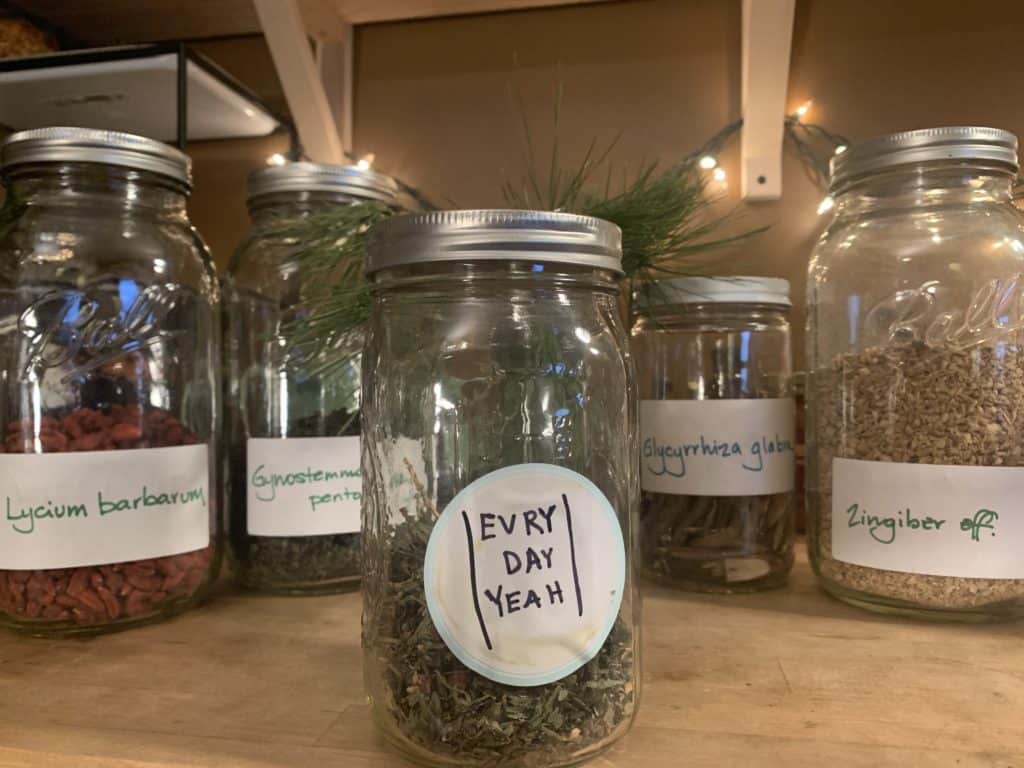EVRY DAY YEAH: Herbal Tea for Workouts & Recovery
This is a formula I’ve come to rely on when I have a big physical challenge to get through. I developed it in preparation for the MovNat Level 3 Certification course I took last year, and it sustained me throughout. I made up another batch before our last big move from one apartment to another, and it made that a lot easier too.
It’s a blend of resilience-building adaptogens, fortifying evergreens, and stabilizing digestives, with the option to include some jitter-free caffeine.
Ingredients & Proportions
- jiaogulan (Gynostemma pentphyllum) leaf, 3 parts
- goji (Lycium barbarum / L. chinense) berry, 3 parts
- cedar (Thuja plicata) leaf, 2 parts
- sage (Salvia officinalis) leaf, 2 parts
- ginger (Zingiber officinale) root/rhizome, 1 part
- licorice (Glycyrrhiza glabra) root, 1/2 part
- yaupon (Ilex vomitoria), guayusa (Ilex guayusa), or yerba mate (Ilex paraguariensis) leaf, 1/2 part – 2 parts (optional, contains caffeine)
Jiaogulan, goji, and licorice are all adaptogens – herbs that improve your capacity to mount an efficient stress response. They provide nutritional needs and targeted support to the endocrine organs, and improve communication between them. For one, these herbs help us come back to a baseline state of calm more easily after stressful events. They also reduce the likelihood of being triggered into a full stress response, unless it’s really needful.
Cedar and sage are moderately astringent herbs with stimulating, activating aromatic constituents. Take a big whiff from an open jar of sage or cedar leaf, you’ll see what I mean. Physically, this combination means that these herbs can both increase metabolic activity and blood movement in the body, while at the same time stabilizing membranes and lending a tonifying influence to the muscles and connectives. There’s a mental correlate here, too: these herbs help your mind stay focused and sharp, while retaining a wide-angle sensorium.
All these herbs lend anti-inflammatory actions as well, which helps in the recovery phase, but ginger is the real standout in that regard. In both digestion and circulation, ginger keeps things warm and flowing – just the opposite of the stiff, creaky, “cold” feelings you might get in your joints when they’ve been overtaxed.
Preparation & Dose
Combine the dried herbs in the proportions given. Store in an airtight container away from heat and light.
To make a quart of tea, put 3-4 heaping spoonsful of the herb mixture in a heat-proof container, pour on boiling water, and steep until cool enough to drink. It’s absolutely ok to let this cool down fully before drinking, or even to drink it iced.
Drink at least a quart on a physically challenging day, and for the following three days as well.
Sourcing The Herbs
Most of these herbs are common in commerce and can likely be found at your local herb shop or co-op market, or a local herb farm. (Support your local businesses!)
You can also look to mail-order suppliers – check out our list of herb suppliers for some options.
Jiaogulan and yaupon are less common in commerce. We don’t normally like to order herbs from Amazon – if you don’t know the supplier, there’s no telling what you’ll get – but this dried jiaogulan has always been great quality. It is from a project that encourages farmers in Thailand to grow jiaogulan instead of opium poppy.
For yaupon, I’ve gotten great-quality herb from Lost Pines and Cat Spring.
Substitutions and Alternatives
You could choose to work with tulsi (Ocimum sanctum / O. tenuiflorum) instead of jiaogulan – it has more aromatic elements and is drying, whereas jiaogulan is moistening and has high saponin content.
In place of goji, you might consider schisandra (Schisandra chinensis), especially if you like sour herbs – schisandra has a wild complex flavor with a lot of sour notes. It’s particularly good if you run hot, constitutionally.
Pine (Pinus spp.) would work great in place of the cedar, but for this herb you’ll want to gather the needles yourself – they don’t last very long when dried and stored. We usually just collect a nice-looking fallen branch when we go out for a walk, and keep it in the house for a few days, stripping off a big handful of needles whenever we make tea.
Fennel (Foeniculum vulgare) is a warming digestive that’s gentler than ginger. It’s a good choice if ginger is too warming for you, or if you run on the dry side – it adds some moistening quality to the formula.
You could work with green or black tea in place of the yaupon/guayusa/mate, if you like. The nice thing about working with the latter herbs – the caffeine hollies – though, is that they don’t have tannins like tea does, so they don’t get bitter when you steep them all day. (I often prepare this in a thermos with a built-in strainer, so they’re in there steeping for a long time.)
Drink Tea EVRY DAY – If You Need It
If you have a physically demanding job, this herbal tea for workouts could become an herbal tea for every day.
I would advise taking the caffeine herbs out of the pre-mixed formula in that case, though. Instead, add it in 1-3 days per week when you need an extra boost. (Caffeine is a more effective stimulant, and has some mood-boosting effects as well, when it’s consumed less than 4 days per week.)

PS: The name for this blend was inspired by some graffiti I used to see in my old neighborhood, on one of my daily walks. (Right up there with ICHABOD as tags go, if you ask me.) There was no context or anything, but it made me happy every time I saw it and soon became a mental mantra.

Join our newsletter for more herby goodness!
Get our newsletter delivered right to your inbox. You'll be first to hear about free mini-courses, podcast episodes, and other goodies about holistic herbalism.
